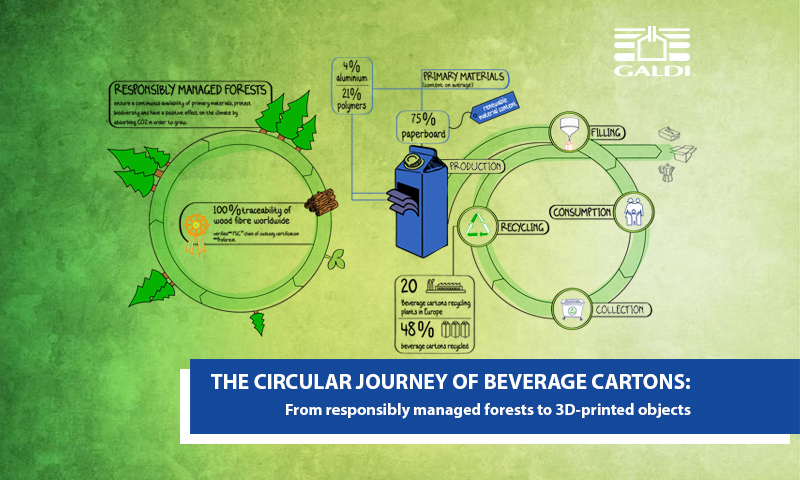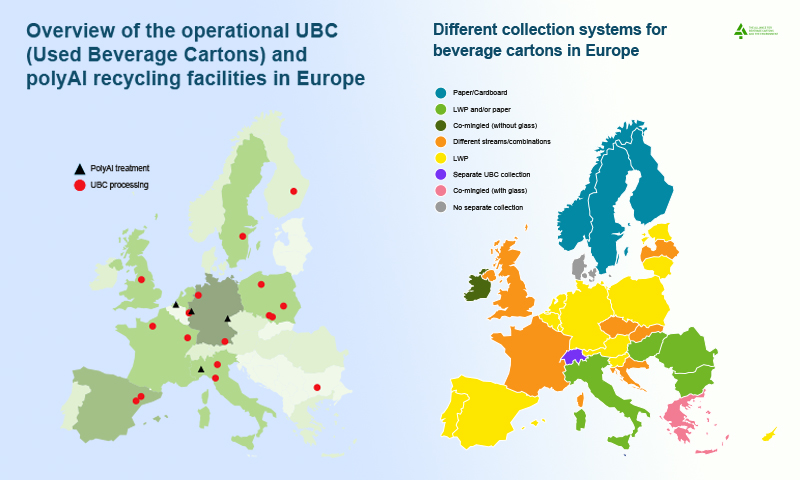The Sustainability of Beverage Cartons
From responsibly managed forests to a new life as paper products and 3D objects: the circular and sustainable journey of beverage cartons

Today, food grade cartonboard is used for an increasing number of products: milk, plant-based drinks, fruit juice, liquid egg, wine, water, and also for dry food, like flour and biscuits.
This type of packaging is 100% recyclable and, if we look at the entire life cycle, using the Life Cycle Assessment (LCA) methodology, also has a lower impact compared to other packaging alternatives.
THE LIFE CYCLE OF BEVERAGE CARTONS
As we are about to see, each stage in the life cycle of a brick container or Gable Top carton is virtuous:
MADE FROM RENEWABLE SOURCES
75% of the package is made from FSC® (Forest stewardship Council®) and PEFC™ (Programme for Endorsement of Forest Certification schemes) certified paper.
PRODUCTION AND TRASPORT
Food cartons have a low impact in terms of CO2 emissions, as they allow for efficient transport and contain a limited amount of plastic. Source: ACE (The Alliance for Beverage Cartons and the Environment).
COLLECTION AND RECYCLING
On average, 51% of cartons are currently recycled in Europe. In Italy, more than 5,000 municipalities have systems in place for the separate collection of beverage cartons. According to the ACE 2030 Roadmap, the goal is to achieve a 90% carton collection rate and at least a 70% recycling rate by 2030.
About 20 paper mills across Europe recycle beverage cartons.
A 100% RECYCLABLE FOOD CONTAINER
Paper-based food packages are made of laminated material, meaning they are composed of multiple layers of different materials:
Besides paper, the materials used are:
● Polymers and biopolymers (21%), which are 100% recyclable and/or renewable. Major producers have pledged to manufacture cartons made of 100% recycled and renewable materials and also reduce the use of plastic by 2030.
● Aluminium (4%, if any): this foil is 8 times thinner than a human hair; the aluminium used for beverage cartons mostly comes from certified suppliers that comply with environmental and social standards at all stages of the production process.
A no-glue lamination process allows for an easier and lower-impact separation of materials in paper mills.
The precious cellulose fibres retrieved in the process are used to manufacture home and personal hygiene paper products.
Recycled polyethylene and aluminium residues are processed and converted into new materials, such as Ecoallene®, Alpe® or GranPlast®, a plastic granulate used to make gadgets, household accessories and street furniture.

CIRCULAR ECONOMY: LUCART'S EXAMPLE
Lucart is one of the paper mills that recycle multi-layer cartons in Italy.
We have recently visited their facility and saw the huge pulper machine, which separates paper from other components, in action.
We also experienced firsthand the company's continuous commitment to making their processes more sustainable. This is a commitment we share at Galdi too!
We were particularly impressed by two circular economy projects they have recently started.
The first one is being carried out in partnership with R3direct.
Thanks to 3D printing technologies, polyethylene and aluminium residues take on a new life. They are turned into design lamps or seats, and even decorative planters with integrated seating, used as barriers in city centres.
The second project will be fully operational by the summer of 2022.
Lucart's Granplast®, obtained from waste Poly-Al, is used to make pallets, which Lucart will use internally for material handling.
In addition to the sustainability of Gable Top cartons, Galdi strives to reduce its environmental impact by following the principles of the circular economy.
We therefore decided to use energy from 100% renewable sources, reduce the consumption of precious resources, such as water for testing, and develop increasingly sustainable packaging systems, thanks to projects such as Eco Design, which we carried out with the University of Padua.
